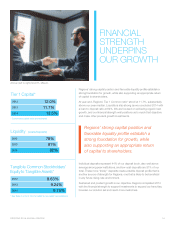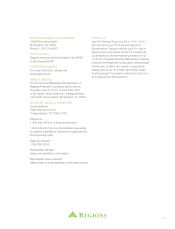Regions Bank 2014 Annual Report Download - page 19
Download and view the complete annual report
Please find page 19 of the 2014 Regions Bank annual report below. You can navigate through the pages in the report by either clicking on the pages listed below, or by using the keyword search tool below to find specific information within the annual report.18 REGIONS 2014 ANNUAL REVIEW
FORWARD-LOOKING STATEMENTS
This 2014 Year in Review, periodic reports filed by Regions Financial
Corporation under the Securities Exchange Act of 1934, as amended, and any
other written or oral statements made by us or on our behalf may include for-
ward-looking statements as defined in the Private Securities Litigation Reform
Act of 1995. The terms “Regions,” “the Company,” “we,” “us” and “our” mean
Regions Financial Corporation, a Delaware corporation and its subsidiaries,
when or where appropriate. The words “anticipates,” “intends,” “plans,” “seeks,”
“believes,” “estimates,” “expects,”“targets,” “projects,” “outlook,” “forecast,”
“will,” “may,” “could,” “should,” “can” and similar expressions often signify for-
ward-looking statements. Forward-looking statements are not based on histori-
cal information, but rather are related to future operations, strategies, financial
results or other developments. Forward-looking statements are based on man-
agement’s current expectations as well as certain assumptions and estimates
made by, and information available to, management at the time the statements
are made. Those statements are based on general assumptions and are sub-
ject to various risks, and because they also relate to the future they are likewise
subject to inherent uncertainties and other factors that may cause actual results
to differ materially from the views, beliefs and projections expressed in such
statements. Therefore, we caution you against relying on any of these forward-
looking statements. These risks, uncertainties and other factors include, but
are not limited to, the risks described below:
• Current and future economic and market conditions in the United States
generally or in the communities we serve, including the effects of declines in
property values, unemployment rates and potential reductions of economic
growth, which may adversely affect our lending and other businesses and
our financial results and conditions.
• Possible changes in trade, monetary and fiscal policies of, and other activities
undertaken by, governments, agencies, central banks and similar organiza-
tions, which could have a material adverse effect on our earnings.
• The effects of a possible downgrade in the U.S. government’s sovereign
credit rating or outlook, which could result in risks to us and general economic
conditions that we are not able to predict.
• Possible changes in market interest rates or capital markets could adversely
affect our revenue and expense, the value of assets and obligations, and the
availability and cost of capital and liquidity.
• Any impairment of our goodwill or other intangibles, or any adjustment of
valuation allowances on our deferred tax assets due to adverse changes in
the economic environment, declining operations of the reporting unit, or
other factors.
• Possible changes in the creditworthiness of customers and the possible
impairment of the collectability of loans.
• Changes in the speed of loan prepayments, loan origination and sale volumes,
charge-offs, loan loss provisions or actual loan losses where our allowance for
loan losses may not be adequate to cover our eventual losses.
• Possible acceleration of prepayments on mortgage-backed securities due to
low interest rates, and the related acceleration of premium amortization on
those securities.
• Our ability to effectively compete with other financial services companies,
some of whom possess greater financial resources than we do and are sub-
ject to different regulatory standards than we are.
• Loss of customer checking and savings account deposits as customers pursue
other, higher-yield investments, which could increase our funding costs.
• Our inability to develop and gain acceptance from current and prospective
customers for new products and services in a timely manner could have a
negative impact on our revenue.
• Changes in laws and regulations affecting our businesses, such as the Dodd-
Frank Act and other legislation and regulations relating to bank products and
services, as well as changes in the enforcement and interpretation of such
laws and regulations by applicable governmental and self-regulatory agen-
cies, which could require us to change certain business practices, increase
compliance risk, reduce our revenue, impose additional costs on us, or
otherwise negatively affect our businesses.
• Our ability to obtain no regulatory objection (as part of the comprehensive
capital analysis and review (“CCAR”) process or otherwise) to take certain
capital actions, including paying dividends and any plans to increase common
stock dividends, repurchase common stock under current or future programs,
or redeem preferred stock or other regulatory capital instruments, may impact
our ability to return capital to stockholders and market perceptions of us.
• Our ability to comply with applicable capital and liquidity requirements (including
the finalized Basel III capital standards), including our ability to generate capital
internally or raise capital on favorable terms, and if we fail to meet requirements,
our financial condition could be negatively impacted.
• The costs, including possibly incurring fines, penalties, or other negative
effects (including reputational harm) of any adverse judicial, administrative, or
arbitral rulings or proceedings, regulatory enforcement actions, or other legal
actions to which we or any of our subsidiaries are a party, and which may
adversely affect our results.
• Our ability to manage fluctuations in the value of assets and liabilities and
off-balance sheet exposure so as to maintain sufficient capital and liquidity
to support our business.
• Possible changes in consumer and business spending and saving habits and
the related effect on our ability to increase assets and to attract deposits,
which could adversely affect our net income.
• Any inaccurate or incomplete information provided to us by our customers
or counterparties.
• Inability of our framework to manage risks associated with our business such
as credit risk and operational risk, including third-party vendors and other ser-
vice providers, which could, among other things, result in a breach of operating
or security systems as a result of a cyber attack or similar act.
• The inability of our internal disclosure controls and procedures to prevent,
detect or mitigate any material errors or fraudulent acts.
• The effects of geopolitical instability, including wars, conflicts and terrorist
attacks and the potential impact, directly or indirectly on our businesses.
• The effects of man-made and natural disasters, including fires, floods,
droughts, tornadoes, hurricanes, and environmental damage, which may
negatively affect our operations and/or our loan portfolios and increase our
cost of conducting business.
• Our inability to keep pace with technological changes could result in losing
business to competitors.
• Our ability to identify and address cyber-security risks such as data security
breaches, “denial of service” attacks, “hacking” and identity theft, a failure of
which could disrupt our business and result in the disclosure of and/or misuse
or misappropriation of confidential or proprietary information; increased
costs; losses; or adverse effects to our reputation.
• Possible downgrades in our credit ratings or outlook could increase the costs
of funding from capital markets.
















